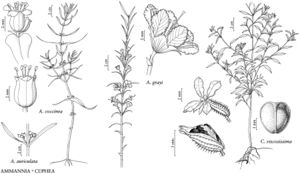Ammannia auriculata
Hort. Berol. 1: 7, plate 7. 1803.
Herbs annual, slender, 1–4 (–8) dm. Stems erect, usually much-branched distal to base. Leaf-blades narrowly linear-lanceolate to linear-oblong, 20–80 × 2–15 mm. Inflorescences simple or compound cymes, (3–) 7–15-flowered mid-stem; peduncle slender (nearly filiform), 3–9 mm. Pedicels slender, 1–3 mm. Floral-tube campanulate to urceolate, 1–3 mm; epicalyx segments shorter than sepals or absent; sepals 4; petals 4, deep rose-purple, 1.5 × 1.5 mm; stamens 4 (–8); anthers deep yellow; style slender, well-exserted, 1+ mm; stigma capitate. Capsules (1–) 1.5–2.5 (–3.5) mm diam., equal to or surpassing sepals, splitting irregularly. 2n = 30 (Egypt), 32 (Mexico, Tanzania).
Phenology: Flowering late spring–late fall.
Habitat: Freshwater marshes, margins of pools and lakes, drying mud and sand flats, ditches, rice fields.
Elevation: 50–1500 m.
Distribution
Kans., Nebr., N.Mex., Okla., S.Dak., Tex., Mexico, West Indies, Central America, South America, Asia, Africa, Australia
Discussion
Ammannia auriculata, the most widely distributed species in the genus, is common and probably native to Africa but sporadic in occurrence, depending on the availability of suitable habitats, which may change from year to year. The species in the flora area is most common in the central United States, where it often grows with A. coccinea or A. robusta.
Selected References
None.
